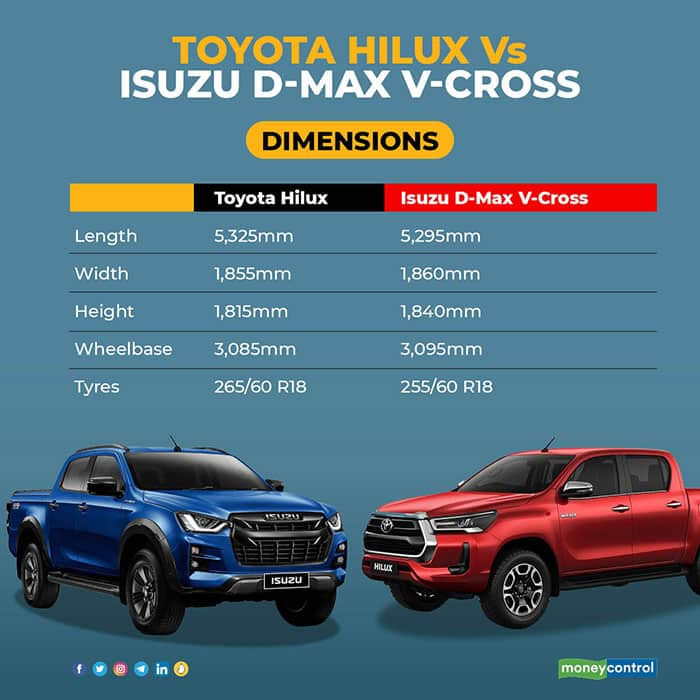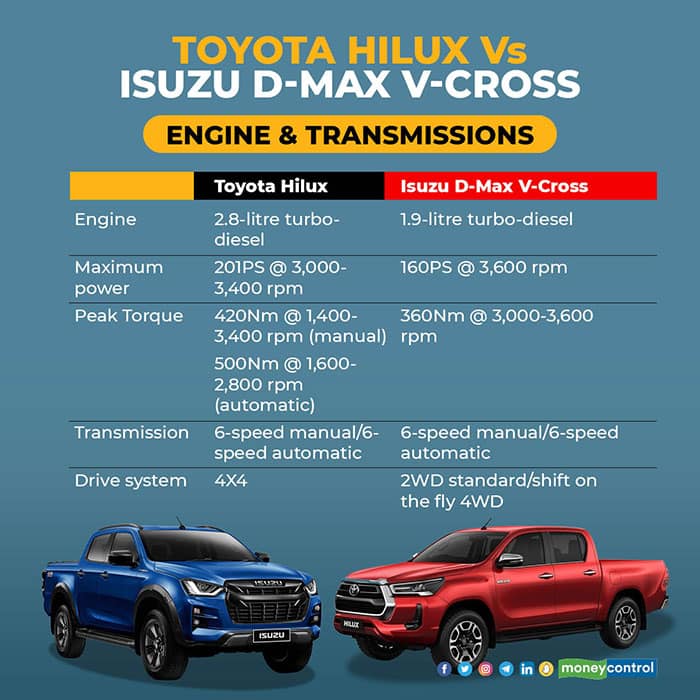
The Hilux will be locally assembled at Toyota’s Bidadi plant in Karnataka.
Toyota on January 20 unveiled the upcoming Hilux and while the company has started accepting bookings, prices for the pickup truck are expected to be announced only in March. The truck has already started arriving at dealerships and will go up against the only other rival in the private pickup truck segment in India, the Isuzu D-Max V-Cross.
Dimensions
Diving straight into what we get to see on the outside, both trucks are rugged, get four-door cabins and a flat bed. What matters, however, is the size of each of these pickups.
The Hilux beats out the V-Cross when it comes to length, stretching 5,325 mm compared to 5,295 mm for the Isuzu. This may mean slightly more legroom in the Hilux, but the V-Cross measures more everywhere else.
The D-Max V-Cross is 1,860 mm wide, 1,840 mm tall and has a wheelbase of 3,095 mm. The Toyota Hilux on the other hand measures 1,855 mm in width, 1,815 mm in height and has a wheelbase of 3,085 mm. This means shoulder room and headroom in the Isuzu could potentially be better.
Both trucks get 18-inch rims as standard but the Hilux uses slightly wider 265/60 section tyres as compared to the Isuzu’s 255/60 sections.

Powertrain
The Hilux is underpinned by the same IMV-2 platform as the Fortuner and Innova Crysta and is powered by the same 2.8-litre turbo-diesel engine mated to either a six-speed manual gearbox or a six-speed automatic transmission. The power plant is capable of 204 PS of maximum power and 420 Nm of peak torque (On the automatic variant, torque rises to 500 Nm.) This means there should be sufficient power on tap when you need to pack in a lot of extra weight into the bed of the truck. The truck comes with 4X4 as standard—there is no two-wheel-drive version.
The Isuzu D-Max V-Cross on the other hand is powered by a smaller 1.9-litre turbo-diesel with, like in the Hilux, a choice of six-speed manual or automatic transmissions. The V-Cross’ engine churns out 160 PS of maximum power and 360 Nm of peak torque. The Isuzu V-Cross comes with two-wheel-drive as standard. However, a shift on the fly 4-wheel-drive system is also available optionally.
Both trucks also get a low-ratio transfer case for better off-road chops.

Features
Both cars should be on comparable terms when it comes to off-road-ability, but safety and creature comforts are a slightly different story with the Hilux offering more on the menu.
The Isuzu, for example, gets a list of features such as a 7-inch touchscreen infotainment system, auto climate control, keyless entry, cruise control, ABS, emergency brake assist, six airbags, brake override system, rear-view camera, traction control, hill descent control and electronic stability control.
The Hilux, on the other hand, brings in seven airbags, hill-start assist, descent control, auto limited slip differential, rear parking camera, ESC, automatic headlamps, 8-inch touchscreen infotainment with Apple CarPlay and Android Auto, auto climate control, cruise control, tilt and telescopic steering column adjustability and a six-speaker sound system.
Prices
Prices for the Hilux are expected to be announced at the time of launch in March. However, we expect the Hilux to be priced at a slight premium over the Isuzu, somewhere in the Rs 25 lakh to Rs 30 lakh range, ex-showroom. The D-Max V-Cross on the other hand starts at a price of Rs 22.07 lakh and goes up to Rs 25.60 lakh, ex-showroom.
However, it is also worth noting that Isuzu offers the entry-level Hi-Lander priced at Rs 19.06 lakh. Bookings for the Toyota Hilux have commenced with the token amount set at Rs 1 lakh and with deliveries to begin after its launch in March.
